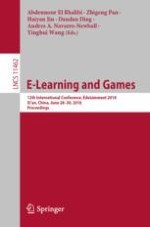2019 | Buch
E-Learning and Games
12th International Conference, Edutainment 2018, Xi'an, China, June 28–30, 2018, Proceedings
herausgegeben von: Abdennour El Rhalibi, Zhigeng Pan, Haiyan Jin, Dandan Ding, Andres A. Navarro-Newball, Yinghui Wang
Verlag: Springer International Publishing
Buchreihe : Lecture Notes in Computer Science
